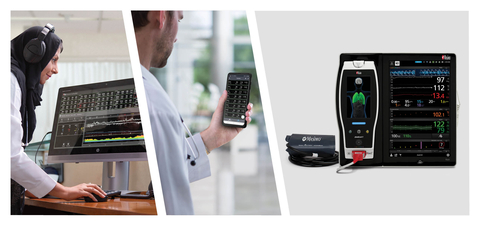New Study Finds That Masimo Patient SafetyNet™ Helped Clinicians Reduce CPR Events and Rates, Improve CPR Success Rate, and Reduce Hospital Length of Stay and Mortality
Masimo (NASDAQ: MASI) revealed a study in PLoS ONE showing that its Patient SafetyNet™ system significantly improved hospital rapid response team (RRT) efficacy. Conducted at King Saud Medical City, the research indicated that RRT activations rose post-implementation, while cardiopulmonary resuscitation (CPR) incidents dropped from 3.3% to 1.95%. Additionally, the average length of hospital stay decreased, and overall mortality fell from 5.45% to 4%. The study concluded that automation through Masimo’s technology could enhance patient outcomes in clinical settings.
- Increased RRT activations from 20 ± 7 to 23.7 ± 9.4.
- Reduced CPR incidents from 3.3% (78 episodes) to 1.95% (42 episodes).
- Lowered average hospital length of stay from 8.7 days to 8.3 days.
- Decreased overall hospital mortality rate from 5.45% to 4%.
- Higher CPR success rate increased from 38.5% to 59.5%.
- None.
Insights
Analyzing...

Masimo Patient SafetyNet™ with Replica® and Root® (Graphic: Business Wire)
Noting that RRT activation depends on the “timely detection of [patient] deterioration,” the researchers sought to determine whether a remote patient surveillance system that automated calculation and relaying of early warning scores could lead to earlier recognition of changes in patient status and the improved efficacy of RRTs. They hypothesized that implementing such a system could decrease the rate of severe adverse events, as a result of potentially quicker RRT activation. To that end, they designed a “before” and “after” study at a large government hospital (1,200 inpatient beds) in central
In the “before” period (retrospective data) nurses manually recorded patient vital signs, calculated warning scores, and activated RRTs; in the “after” period” (prospective data), vital signs data collected at the bedside, alongside automatically calculated warning scores, were wirelessly relayed to nursing stations for centralized remote patient surveillance and RRT activation. Both before and after, activation of an RRT was triggered when a patient’s vital signs deteriorated to the point they scored ≥ 5 on the MEWS (Modified Early Warning Score) scale. “Before” group data was analyzed from 2,346 adult patients from January to
The researchers found that in the “before” group, there were 78 episodes of CPR over 20,510 total inpatient days, for an incidence of
The investigators concluded, “Automated activation of the RRT by Masimo Patient SafetyNet applied to medical ward patients significantly reduced CPR events and rates, reduced hospital length of stay, and increased the number of RRT activations. There was no difference in the ICU admission rates. Further evaluation of the system in surgical wards and mixed settings [should be] conducted.”
@Masimo | #Masimo
About Masimo
Masimo (NASDAQ: MASI) is a global medical technology company that develops and produces a wide array of industry-leading monitoring technologies, including innovative measurements, sensors, patient monitors, and automation and connectivity solutions. In addition, Masimo Consumer Audio is home to eight legendary audio brands, including Bowers & Wilkins, Denon, Marantz, and Polk Audio. Our mission is to improve life, improve patient outcomes, and reduce the cost of care. Masimo SET® Measure-through Motion and Low Perfusion™ pulse oximetry, introduced in 1995, has been shown in over 100 independent and objective studies to outperform other pulse oximetry technologies.2 Masimo SET® has also been shown to help clinicians reduce severe retinopathy of prematurity in neonates,3 improve CCHD screening in newborns,4 and, when used for continuous monitoring with Masimo Patient SafetyNet™ in post-surgical wards, reduce rapid response team activations, ICU transfers, and costs.5-8 Masimo SET® is estimated to be used on more than 200 million patients in leading hospitals and other healthcare settings around the world,9 and is the primary pulse oximetry at 9 of the top 10 hospitals as ranked in the 2022-23
ORi, RPVi, and Radius VSM have not received FDA 510(k) clearance and are not available for sale in
References
-
Balhi AN, Al-Odat MA, Alharthy AM, Alshaya RA, Alenzi HM, Dambung AS, Mhawish H, Altamimi SM, Aletreby WT.
Tele-Rapid Response Team (Tele-RRT): The effect of implementing patient safety network system on outcomes of medical patients—A before and after cohort study. PLoS ONE. 17(11):e0277992. https://doi.org/10.1371/journal.pone.0277992. - Published clinical studies on pulse oximetry and the benefits of Masimo SET® can be found on our website at http://www.masimo.com. Comparative studies include independent and objective studies which are comprised of abstracts presented at scientific meetings and peer-reviewed journal articles.
- Castillo A et al. Prevention of Retinopathy of Prematurity in Preterm Infants through Changes in Clinical Practice and SpO2 Technology. Acta Paediatr. 2011 Feb;100(2):188-92.
- de-Wahl Granelli A et al. Impact of pulse oximetry screening on the detection of duct dependent congenital heart disease: a Swedish prospective screening study in 39,821 newborns. BMJ. 2009;Jan 8;338.
- Taenzer A et al. Impact of pulse oximetry surveillance on rescue events and intensive care unit transfers: a before-and-after concurrence study. Anesthesiology. 2010:112(2):282-287.
- Taenzer A et al. Postoperative Monitoring – The Dartmouth Experience. Anesthesia Patient Safety Foundation Newsletter. Spring-Summer 2012.
-
McGrath S et al. Surveillance Monitoring Management for General Care Units: Strategy, Design, and Implementation.
The Joint Commission Journal on Quality and Patient Safety . 2016 Jul;42(7):293-302. - McGrath S et al. Inpatient Respiratory Arrest Associated With Sedative and Analgesic Medications: Impact of Continuous Monitoring on Patient Mortality and Severe Morbidity. J Patient Saf. 2020 14 Mar. DOI: 10.1097/PTS.0000000000000696.
- Estimate: Masimo data on file.
- http://health.usnews.com/health-care/best-hospitals/articles/best-hospitals-honor-roll-and-overview.
Forward-Looking Statements
This press release includes forward-looking statements as defined in Section 27A of the Securities Act of 1933 and Section 21E of the Securities Exchange Act of 1934, in connection with the Private Securities Litigation Reform Act of 1995. These forward-looking statements include, among others, statements regarding the potential effectiveness of Masimo Patient SafetyNet™ and Replica® These forward-looking statements are based on current expectations about future events affecting us and are subject to risks and uncertainties, all of which are difficult to predict and many of which are beyond our control and could cause our actual results to differ materially and adversely from those expressed in our forward-looking statements as a result of various risk factors, including, but not limited to: risks related to our assumptions regarding the repeatability of clinical results; risks related to our belief that Masimo's unique noninvasive measurement technologies, including Masimo Patient SafetyNet and Replica, contribute to positive clinical outcomes and patient safety; risks that the researchers’ conclusions and findings may be inaccurate; risks related to our belief that Masimo noninvasive medical breakthroughs provide cost-effective solutions and unique advantages; risks related to COVID-19; as well as other factors discussed in the "Risk Factors" section of our most recent reports filed with the
View source version on businesswire.com: https://www.businesswire.com/news/home/20230104006029/en/
Media Contact:
Masimo
949-396-3376
elamb@masimo.com
Source: Masimo







